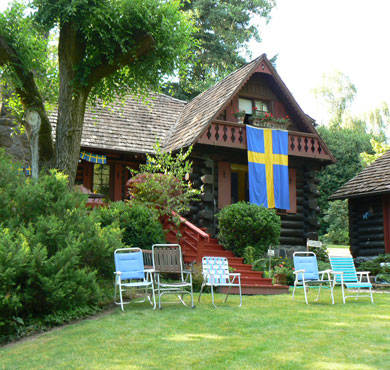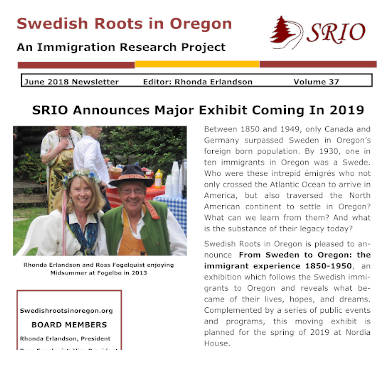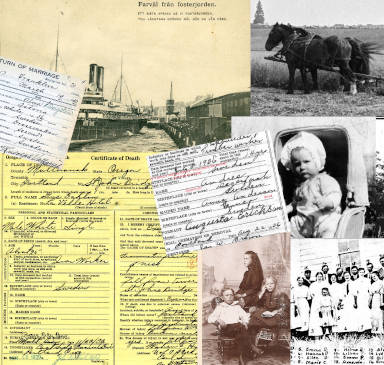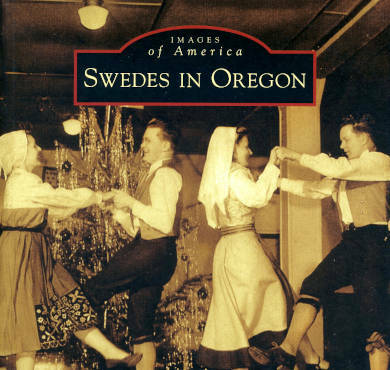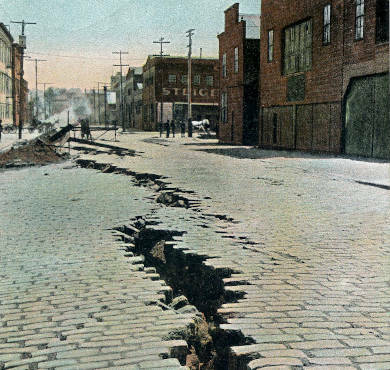Introduction
During the first half of the 20th century, the Swedish born – in combination with other Scandinavians – made up the largest group of Oregon’s foreign-born population. But as the Great Depression set in, Swedish emigration turned into re-migration and ten times the number of Swedes returned home than came to the United States. World War II made civilian travel almost impossible and people on both sides of the Atlantic stayed put. Following the war, as conditions in Sweden rapidly improved, no new wave of emigrants ever developed. Compared to the earlier figures, postwar emigration was reduced to a trickle. This historical development had important consequences for the community of Swedes in Oregon.
Without the influx of new speakers, the use of the Swedish language began to decline in churches, organizations and family life. Portland’s Swedish stores, restaurants and services started disappearing as the older generation began dying off. Without the ability to speak Swedish it was not as easy to pass on customs and traditions to the next generation. It also became much more difficult to keep in touch with relatives in Sweden and to stay informed about the great changes that characterized postwar Sweden. The immigrant’s memory of Sweden and the actual postwar Swedish society often became two completely different worlds. What happened to the Swedish community also happened to the other Scandinavian groups, and one could say that the second half of the 20th century was characterized by a move from a Swedish to a Swedish-American to a Scandinavian-American community. This kind of consolidation has been the only way to maintain a sense of ethnic cohesiveness and unity as new and much larger ethnic groups increasingly have found their way to Oregon and the Pacific Northwest. Where will this development lead? In his interesting postscript, “Changing Perspectives,” Barry Peterson gives us few hints of what the future may hold for the Swedish-American community.
Lars Nordström, Ph. D.
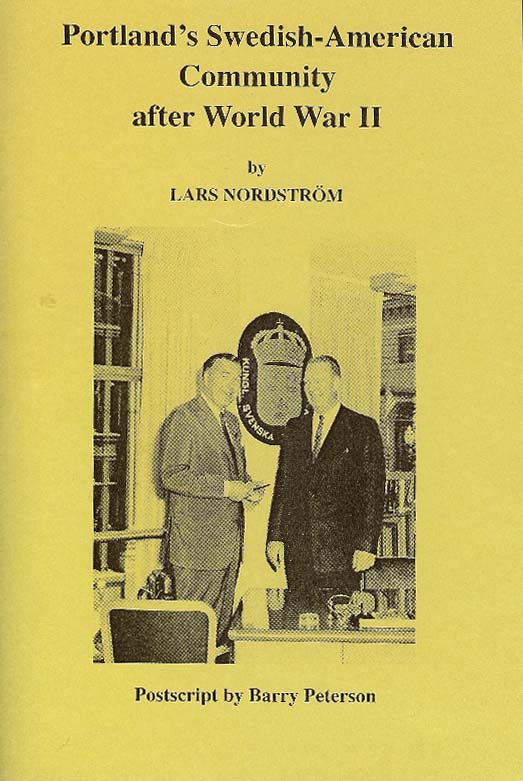
Excerpt – Portland’s Swedish-American Community after World War II
If one takes a look at the 1960 Midsummer Program for Portland, one is struck by the large number of Swedish and Scandinavian organizations that were active in the city. There was the Skandia Lodge No.68 (for men) and Rosen Lodge No.50 (for women), the Scandinavian Men’s Club, the Swedish Male Chorus, the Nobel Lodge No. 184 and Harmoni Lodge 472, The Order of Runeberg, The Swedish Club and the Swedish Society Linnea. With this vibrant Swedish-American community in Portland, it is not surprising that the city became a magnet that attracted various regional conventions. That same year, 1960, The Vasa Order of America held its 27th Convention of the Pacific Northwest District in Portland, and it was a big event that was opened by Portland Mayor Terry Shrunk.
In 1963, another very large convention was held in Portland, the biennial convention of the American Union of Swedish Singers. In 1962 the Swedish Vice Consul Malcolm B. Frykman was voted “Scandinavian of the Year” by the Scandinavian Men’s Club. The combination of his personal energy, the indefatigable Swedish couple Oscar and Mary Näström promoting all kinds of Swedish community activities, and the general American interest in Sweden helped create a decade of surging Swedish exposure in Oregon. In 1964, several years of planning and preparations came together. The Swedish industrial giant ASEA had become involved in supplying parts and expertise for the high-voltage transmission power grid in the NW, moving the electrical power generated on the Columbia River by the Bonneville Power Administration throughout the Pacific Northwest and to California. An exhibit at Portland’s Oregon’s Museum of Science and Industry (OMSI) that year explained what was going on. In June 1964, a “Sweden Week in Portland” was organized with help from the Swedish Chamber of Commerce in San Francisco, but it was only a prelude to what was to come in the fall. Towards the end of the summer, Mayor Terry D. Shrunk proclaimed September 25 to October 25 “Meet Modern Sweden in Portland.” The month caught the attention of the whole city. According to The Oregonian, some “50 stores featur[ed] Swedish merchandise and Swedish fashion shows. Restaurants served Swedish dishes and the Portland Art Museum presented a show of the work of Ernst Josephson, Swedish artist.” Swedish art historian Dr. Ingrid Mesterton was the curator of the show, which premiered the artist’s work in the United States. (This art show later traveled to a number of US cities before returning to Sweden.) The exhibit also included a display of Swedish art glass. The well-known Swedish poet and art critic Erik Blomberg was even brought over to give two lectures on Ernst Josephson. Next door, Portland State College exhibited graphic prints by Swedish artist Anders Zorn, and at OMSI there was a very successful exhibit of items from the Swedish warship WASA. This ship had sunk on its maiden voyage in the Stockholm harbor, and had become a spellbinding time capsule from 1628. The Multnomah County Library, Portland’s main library downtown, participated by displaying 30 screens on the theme “Sweden – USA: Friendship – Culture – Trade.”
“Meet Modern Sweden in Portland” turned out to be a great success and three of the organizers were recognized the following year. The Swedish Vice Consul Malcolm B. Frykman received Knighthood, First Class of the Royal Order of Vasa. The Director of the Portland Art Museum, Dr. Francis J. Newton, who had studied at the Royal Academy of Art in Stockholm in the late 1930s, received the Swedish King’s Royal Order of the North Star. Mary Näström was awarded the Royal Order of Vasa for her many contributions to the Swedish-American community. These honors were certainly noticed by the press, and may have been the first ever awarded to individuals in Oregon.
In the fall of 1966 SAS opened direct flights between Seattle and Copenhagen, a route that is still trafficked today, forty years later. Airplanes were now capable of ferrying people between the Pacific Northwest and Scandinavia in just ten hours – the same amount of time it takes today, 40 years later. That this was seen as a great new potential for growth in trade and tourism is revealed by the fact that 62 Pacific Northwest civic and business leaders (many Oregonians among them) had been invited to visit Scandinavia as the paid guests of SAS on the inaugural flight. A “Sixties” sense of exhilaration generated by the speed with which people and things could now be moved across the planet can be caught in a newspaper headline just four months later. “A Scandinavian fashion collection shown in Paris is being jetted to Waverly Country Club [in Portland] for showing at the 7 PM dinner-dance Saturday, January 28.” The jet age had arrived, and with it a new, exciting verb form. And what was being served for dinner at the country club that night? A “Polar Flight Menu,” of course.
During the 1960s the Swedish diplomatic corps in the United States consisted of a Swedish Ambassador in Washington D.C., a Consul General of Sweden stationed in San Francisco representing the American West, as well as some 25 to 30 Swedish vice consulates and/or honorary consulates scattered across the US. In 1967, as a result of the growth in trade and cultural exchanges during the previous decade, Portland’s Vice Consulate was elevated to a full-fledged Consulate. In a statement to the press that year, Swedish Consul General Carl-Henrik Petersén claimed that: “Sweden is closely ‘attached’ to the Pacific Northwest for two major reasons: There are many persons of Swedish extraction here, and this part of the United States is ‘extremely important’ as a market for Swedish exports.” This development did not go unnoticed by one of Oregon’s US Senators, Mark O. Hatfield: “I was pleased to read in a recent paper from home that Oregon now has a full-fledged Swedish consulate and that you have been designated as the official Swedish Consul.” It was an important relationship that was cultivated equally by the Americans and the Swedes.
For the next six or seven years, Sweden managed to linger in the Oregon spotlight. In the fall of 1968 there was a series of free cultural exchange lectures in Portland entitled “Salute to Scandinavia,” which received a lot of attention and praise in the local media. Over the next couple of years, a number of cultural exchanges were organized. There were, among many other, various Swedish musical performances, several small Swedish art exhibits in the state, a visit by a troupe of Swedish gymnasts sponsored by the Oregon Swedish Male Chorus, and a first time ever visit to Portland by the Royal Swedish Ballet in late October, 1974.
But Sweden emerged in the American news for another reason as well, and that was one on a much more contentious issue, namely the Vietnam War. Relatively early in the conflict, the Swedish government (the Social Democrats were in power at the time) took an official public stand against US aggression in Vietnam and diplomatic relations between the two countries quickly became frosty. As a result, on one of his many visits to Portland, the Swedish Ambassador was not interviewed about trade or cultural exchange between the two countries, but was instead asked to comment on the Swedish government policy of granting asylum to young Americans trying to avoid the Vietnam War. Swedish Ambassador “Defends Swedish Sanctuary Policy,” The Oregonian headline reads. Even though the ambassador claimed that Great Britain took five times as many American asylum seekers as the Swedes, they did so secretly, and it was only because Sweden admitted them openly that it had become a contentious and overblown issue in the press. As an aside, it should be noted that the Vietnam War was hotly debated in the shrinking Swedish-American press too, and it is worth observing that Svenska Posten in Seattle was the only Swedish-American newspaper that was openly critical to the war.
As the statistics show, few Swedes found their way to the US or to Oregon during the entire postwar period, but many other ethnic groups (Mexicans and Central Americans, Russians, Vietnamese, Chinese and Japanese) started coming in increasingly large numbers. There had been substantial Chinese and Japanese populations in Oregon for a long time, but both groups had been treated less than fairly and had fought hard to gain public recognition as citizens of equal standing. So as Oregon’s population increased and Portland started growing, the new large immigrant groups started receiving increasing attention. In 1976 the creation of a new festival called “Folkfest of Portland” demonstrated that Oregon was becoming an ethnically diverse state with a new mix. The new Folkfest involved approximately 50 different groups. The organizers launched it “to promote harmony among Ethnic Groups and foster an appreciation of our many different cultures.” The Swedish-Americans were certainly well represented, but they were now but one facet in a large multicultural diamond. Perhaps related to the changing demographics was the increasing orientation in Oregon toward trade and exchange with Asia, to what was eventually referred to as “Pacific Rim” countries. So with a steady flow of news, growing trade and immigration from Asia during and after the Vietnam War, Oregon’s attention to immigrant cultural life was reoriented. Inevitably this development meant a turning away from Europe.
